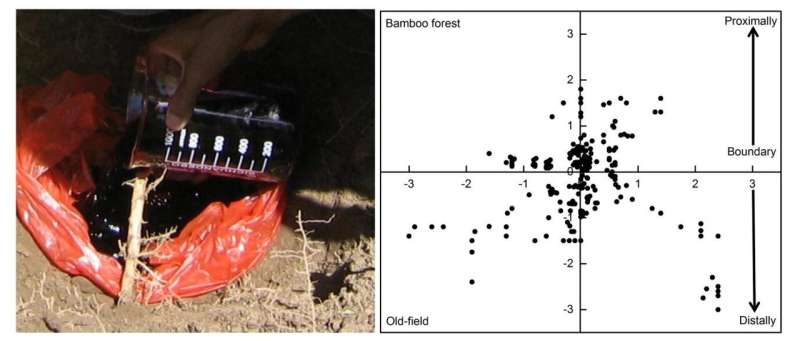Dyeing experiment design and deployment in the field. Left picture shows how fuchsin dye was incorporated into the rhizomes, and the right figure is an example of how dye traveled to various ramets/ stems from the incorporation point (0,0). Credit: Lu Zhijun
Bashania fargesii bamboo is an important dominant understory species influencing community structure and regeneration of overstory trees, and it serves as an important food source for giant panda in the Qinling Mountains. B. fargesii invades old fields via clonal rhizome growth. However, the pattern of bamboo invasion into old fields and the role of physiological integration during bamboo expansion and regeneration, especially under giant panda herbivory are unclear.
Researchers from the Wuhan Botanical Garden of the Chinese Academy of Sciences and University of Northern Colorado set up 25 tansects in the Foping National Reserve to detect B. fargesii invasion pattern. They used acid fuchsin dye solution to examine clonal integration (water sharing), and set up a controlled experiment to examine whether clonal integration can help bamboo regeneration under giant panda herbivory.
Together, the experiments are helpful to further understand the role of clonal integration for the regeneration of B. fargesii especially under giant panda herbivory.
The researchers found B. fargesii invasion appeared at early succession stages (annuals, perennials and shrubs), but decreased over time and dropped out in 20 years, demonstrating the temporary occurrence of B. fargesi in old fields. Old field invasion appeared facilitated by clonal integration, as ramets at the boundary of old fields and bamboo forest shared water both distally and proximally.
Furthermore, intermediate disturbance (mocking herbivory) and rhizome serving enhanced B. fargesii regeneration in the short- time (the first two years in this case), especially for numbers of leaves and branches (ramet foraging), but the impact lessened over time.
The results provide some scientific bases for future sustainable bamboo forest management for giant panda habitat conservation.
Results have been published in Forest Ecology and Management, titled "Clonal integration and regeneration in bamboo Bashania fargesii."
More information: Zhijun Lu et al, Clonal integration and regeneration in bamboo Bashania fargesii, Forest Ecology and Management (2022). DOI: 10.1016/j.foreco.2022.120504
Journal information: Forest Ecology and Management
Provided by The Chinese University of Hong Kong
























